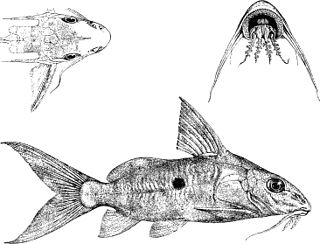
The channel catfish is North America's most numerous catfish species. It is the official fish of Kansas, Missouri, Iowa, Nebraska, and Tennessee, and is informally referred to as a "channel cat". In the United States, they are the most fished catfish species with around 8 million anglers targeting them per year. The popularity of channel catfish for food has contributed to the rapid expansion of aquaculture of this species in the United States. It has also been widely introduced in Europe, Asia and South America, and it is legally considered an invasive species in many countries.

The Amblycipitidae are a family of catfishes, commonly known as torrent catfishes. It includes three genera, Amblyceps, Liobagrus, and Xiurenbagrus, and about 36 species.

The Cetopsidae are a small family of catfishes, commonly called the whale catfishes.

The Bagridae are a family of catfish that are native to Africa (Bagrus) and Asia from Japan to Borneo. It includes about 245 species. These fish are commonly known as naked catfishes or bagrid catfishes.

Acanthicus is a genus of large, South American suckermouth armored catfishes native to the Amazon and Orinoco basins, and possibly in Guyana. The name Acanthicus is derived from the Greek, akanthikos meaning thorny, spiny. Fish of this genus are known as lyre-tail plecos. These species are found in large rivers, primarily in areas with a rocky bottom and a moderate or strong current.
Amblyceps is a genus of fish in the family Amblycipitidae. The genera Amblyceps and Liobagrus are sister group pair that is, in turn, sister to Xiurenbagrus. These species are easily distinguished by the presence of pinnate processes along the median caudal-fin rays, a prominent cup-like skin flap above the base of the pectoral spine and the adipose fin largely separate from the caudal fin. In most species the caudal fin is deeply forked; A. apangi and A. murraystuarti differ in having their caudal fin truncate. Amblyceps species may reach about 100 millimetres (3.94 in) SL.
Xiurenbagrus is a genus of torrent catfishes of the family Amblycipitidae. It includes three species.

Liobagrus is a genus of catfishes of the family Amblycipitidae. Liobagrus fishes are distributed in the Yangtze River basin, Taiwan, Japan, and the Korea Peninsula. The adipose fin of these fishes is a confluent with the caudal fin. The nostrils are far apart, unlike those found in Amblyceps. Most Liobagrus species grow to about 100 millimetres (3.94 in) SL.

Bagarius is an Asian genus of catfishes of the family Sisoridae. It includes five to six extant species and potentially one extinct fossil species, B. gigas.
Breitensteinia is a genus of catfishes of the family Akysidae. It includes three species.

Acrochordonichthys is a genus of catfishes of the family Akysidae. It includes ten species.

Synodontis grandiops is a species of upside-down catfish endemic to the Democratic Republic of the Congo, Burundi, and Tanzania, where it is only known from Lake Tanganyika. It was first described by Jeremy John Wright and Lawrence M. Page in 2006, from specimens collected at multiple points along the shore of Lake Tanganyika. The species name is a Latinized combination of the Latin "grandi", meaning large or big, and the Greek "ops", meaning eye, a reference to the relatively large eyes of this fish.

Synodontis nummifer, known as the two spot synodontis, is a species of upside-down catfish native to the Congo Basin of Cameroon, the Democratic Republic of the Congo and the Republic of the Congo. It was first described by the Belgian-British zoologist George Albert Boulenger in 1899, based upon a holotype discovered in Léopoldville, Belgian Congo. The specific name "nummifer" comes from the Latin for "to bear a coin", which refers to the large spots on its sides.

Synodontis melanostictus is a species of upside-down catfish endemic to Lake Tanganyika and its tributaries. It has been found in Zambia, the Democratic Republic of the Congo, and Burundi. It was first described by British-Belgian zoologist George Albert Boulenger in 1906, based upon a specimen from the Lofubu River. The species name "melanostictus" is derived from a combination of the Greek melano, meaning black, and the Greek stiktos, meaning punctured or spotted. This refers to the black spotted pattern that occurs on the body of this species.
Liobagrus chenghaiensis is a species of catfish in the family Amblycipitidae endemic to China, where it is only known from lake Chenghai in the province of Yunnan.
Liobagrus somjinensis is a species of catfish in the family Amblycipitidae. It is known from the western and southern coasts of Korea and Geogeum Island, where it has been found in rivers and tributaries. L. somjinensis can be distinguished physically from other torrent catfish by the unusual length of its dorsal spine and outer mental barbel and the shortness of the distance from its dorsal-fin insertion point to its adipose-fin point of origin, as well as by markings and coloration on the fins. The caudal fin displays a broad vertical band in its center, yellow in hue and shaped like a crescent, while the dorsal, anal, and caudal fins have deep black colour on their outer margins. It grows to 10.1 cm (4.0 in) standard length.
Liobagrus marginatoides is a species of catfish in the family Amblycipitidae endemic to the province of Sichuan in China. This species reaches a length of 8.5 centimetres (3.3 in) SL.
Liobagrus obesus, the bull-head torrent catfish, is a species of catfish in the family Amblycipitidae endemic to South Korea, where it occurs in the middle parts of the Geum, Mangyeong, and Yeongsan rivers. This species reaches a length of 10 centimetres (3.9 in) TL.

Liobagrus reinii is a species of catfish in the family Amblycipitidae endemic to Japan. This species reaches a length of 9 centimetres (3.5 in).
Liobagrus styani is a species of catfish in the family Amblycipitidae endemic to the province of Hubei in China. This species reaches a length of 12 centimetres (4.7 in) TL.










